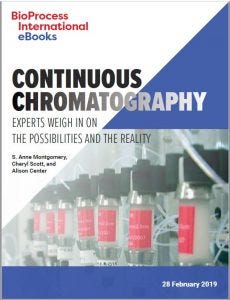Continuous Chromatography: Experts Weigh in on the Possibilities and the Reality
 Discussions of continuous processing in the biopharmaceutical industry are an important part of current efforts toward intensifying bioproduction and bioprocessing. Biomanufacturers are looking at all components of their development and manufacturing processes for ways to reduce the size of their facilities, lower costs, and increase speed and flexibility of operations. Increasing options for and availability of single-use technologies have been major enablers of myriad attempts to improve efficiencies. Although the general consensus may still be that single-use components are more conducive to continuous upstream than to downstream processing, process intensification efforts to streamline manufacturing operations already have been challenging those assumptions in the past few years. Through new sensors, automation, and process control technologies, biomanufacturers can take advantage of greater connectivity of unit operations (1). Some are implementing hybrid processes (combining both continuous and batch unit operations throughout a manufacturing process), a few are attempting fully continuous unit operations, and many continue to use end-to-end processes based on staggered batch unit operations.
Discussions of continuous processing in the biopharmaceutical industry are an important part of current efforts toward intensifying bioproduction and bioprocessing. Biomanufacturers are looking at all components of their development and manufacturing processes for ways to reduce the size of their facilities, lower costs, and increase speed and flexibility of operations. Increasing options for and availability of single-use technologies have been major enablers of myriad attempts to improve efficiencies. Although the general consensus may still be that single-use components are more conducive to continuous upstream than to downstream processing, process intensification efforts to streamline manufacturing operations already have been challenging those assumptions in the past few years. Through new sensors, automation, and process control technologies, biomanufacturers can take advantage of greater connectivity of unit operations (1). Some are implementing hybrid processes (combining both continuous and batch unit operations throughout a manufacturing process), a few are attempting fully continuous unit operations, and many continue to use end-to-end processes based on staggered batch unit operations.
Focusing on downstream efforts to develop continuous processes, some people believe that “continuous production appears to be the first system that will see large-scale implementation because it still leverages the selectivity offered by conventional chromatography resins” (2). Here we look at some key issues and current progress behind implementation of continuous chromatography. It offers a means to overcome batch-column limitations by using membranes or multiple columns that operate continuously in different phases of a manufacturing cycle — or even by running a resin slurry through modular stages that perform chromatographic operations simultaneously in a steady state. The latter is said to increase yield and purity while reducing buffer consumption and facilitating advanced process analytical technology (PAT) and process control implementation (3).
Just fill out this form to download the eBook now.
You May Also Like





